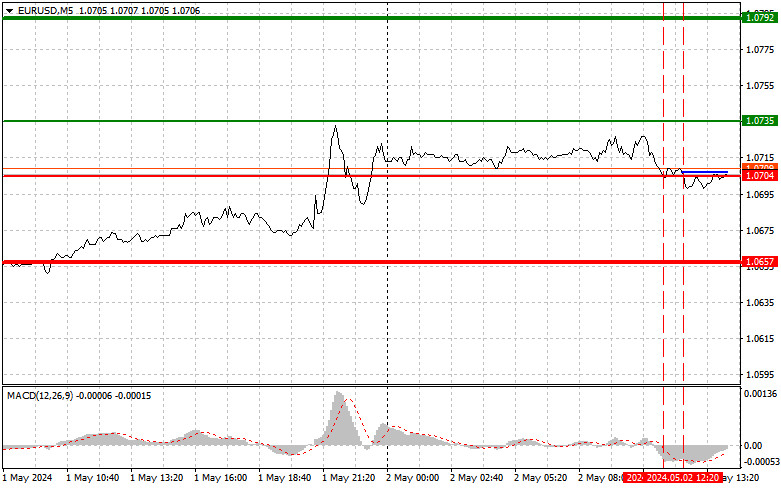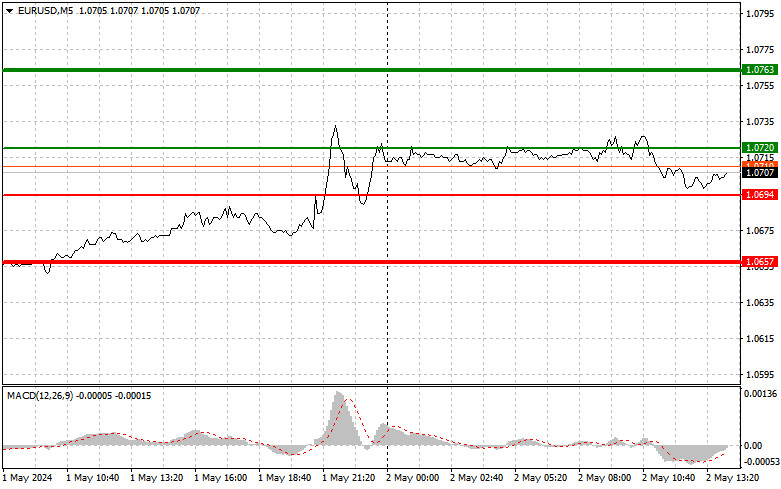
Analysis of trades and trading tips for the European currency
The first price test at 1.0704 in the first half of the day occurred when the MACD indicator had dropped significantly below the zero mark, limiting further downward potential for the pair. For this reason, I did not sell and instead waited for a retest to execute scenario #2 for buying. After a short period, the retest of 1.0704 while the MACD was in oversold territory allowed my plans to materialize, but the pair did not experience significant growth. Data on the manufacturing activity of Eurozone countries could have been more pleasant as the economy continues to face difficulties in this direction. Ahead of us, we expect figures on the weekly number of initial jobless claims, the balance of trade, changes in labor productivity in the non-manufacturing sector, and changes in labor cost. All these indicators are unlikely to significantly influence market direction, so if euro buyers do not show themselves after the release of statistics, pressure on the pair is likely to increase. As for the intraday strategy, I plan to act based on the implementation of scenarios #1 and #2.

Buy Signal
Scenario #1: Today, I plan to buy the euro when the price reaches around 1.0720 (green line on the chart), with the target of rising to the level of 1.0763. At the point of 1.0763, I will exit the market and also sell the euro in the opposite direction, counting on a movement of 30-35 pips from the entry point. Today, the rise of the euro can only be expected after weak US statistics, as there will be no other reasons to buy the euro. Important! Before buying, make sure that the MACD indicator is above the zero mark and is only beginning to rise from it.
Scenario #2: I also plan to buy the euro today in case of two consecutive tests of the price at 1.0694 while the MACD is in oversold territory. This will limit the downward potential of the pair and lead to a reverse market turnaround upwards. Expect growth to the opposite levels of 1.0720 and 1.0763.
Sell Signal
Scenario #1: I will sell the euro after reaching the level of 1.0694 (red line on the chart). The target will be the level of 1.0657, where I plan to exit the market and buy the euro immediately in the opposite direction (counting on a movement of 20-25 pips in the opposite direction from the level). Pressure on the pair will return in case of a lack of buyer activity around the daily maximum and strong US data. Important! Before selling, make sure that the MACD indicator is below the zero mark and is only starting to decline from it.
Scenario #2: I also plan to sell the euro today in case of two consecutive tests of the price at 1.0720 while the MACD is in overbought territory. This will limit the upward potential of the pair and lead to a reverse market turnaround downwards. Expect a decline to the opposite levels of 1.0694 and 1.0657.

What's on the chart:
Thin green line - entry price, at which you can buy the trading instrument.
Thick green line - the expected price where you can set Take Profit or manually take profits, as further growth above this level is unlikely.
Thin red line - entry price, at which you can sell the trading instrument.
Thick red line - the expected price where you can set Take Profit or manually take profits, as further decline below this level is unlikely.
MACD indicator. When entering the market, it is important to consider overbought and oversold zones.
Important. Beginner traders in the forex market need to be very careful when making decisions to enter the market. Before important fundamental reports, it is best to stay out of the market to avoid getting caught in sharp exchange rate fluctuations. If you decide to trade during news releases, always set stop orders to minimize losses. You need to set stop orders to avoid losing your entire deposit, especially if you do not use money management and trade in large volumes.
And remember, successful trading requires a clear trading plan, similar to the one presented by me above. Spontaneous decision-making based on the current market situation is inherently a losing strategy for an intraday trader.